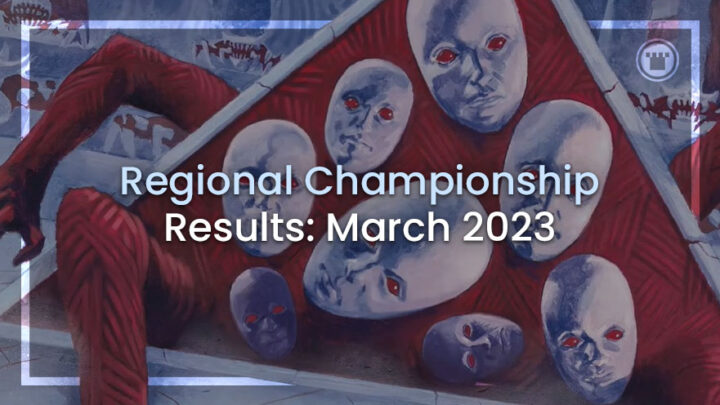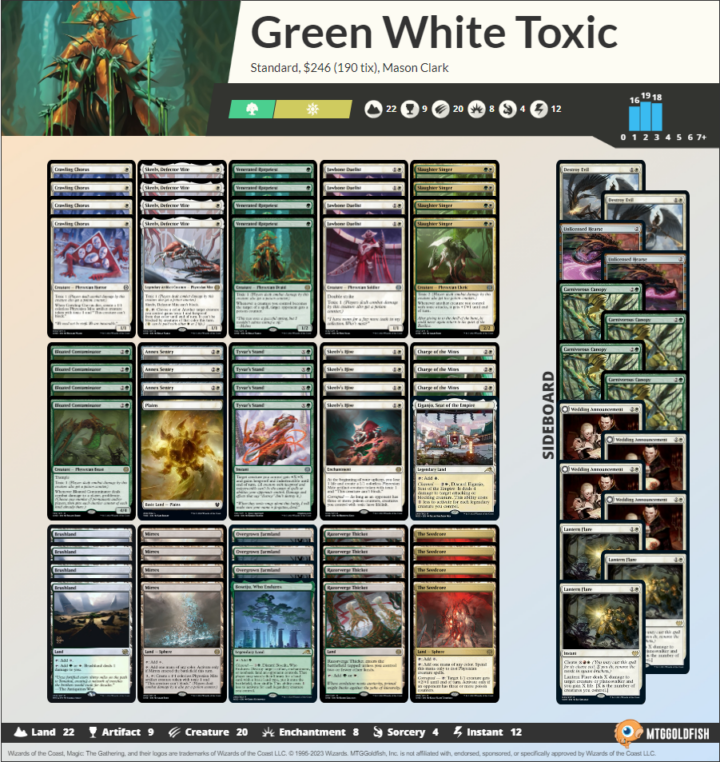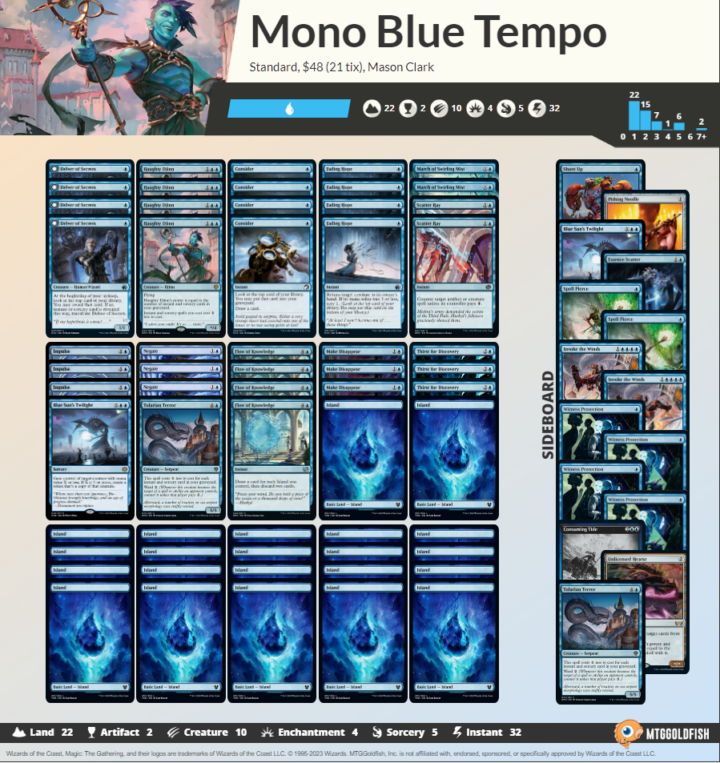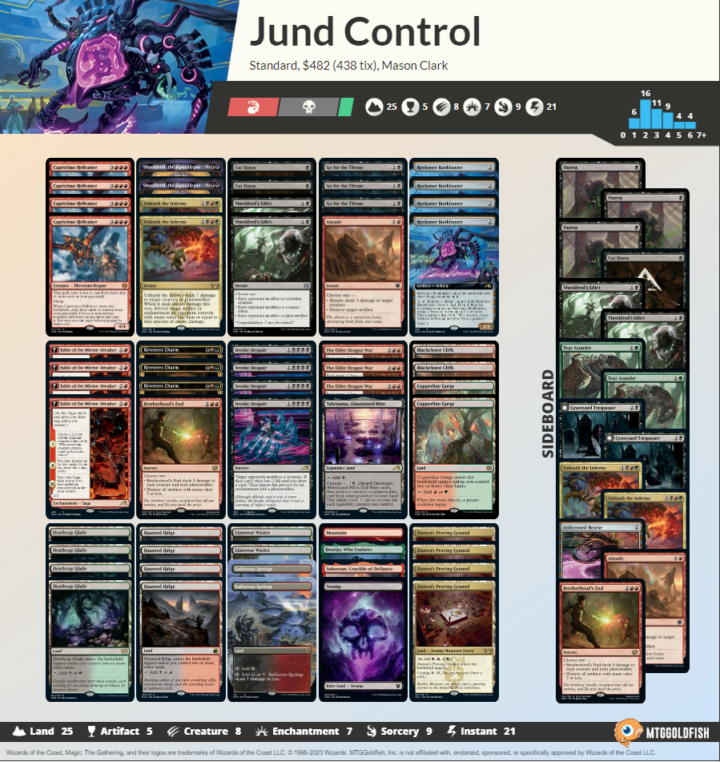Last weekend, the competitive Magic scene saw the first few Regional Championship results of the season. Players flocked to see what the best from each region brought, and to the surprise of few, Grixis dominated in these events. But it’s not time to start spreading doom and gloom — it’s time to start looking at the outliers.
There were a few players who succeeded by breaking away from conventional wisdom, and it’s there where we may find an answer to the current Grixis lists. Let’s take a look.
Green White Toxic
Green-White Toxic is the deck everyone saw but no one built. This list is basically a block constructed deck from All Will Be One, filled with cheap creatures using the Toxic mechanic that aim to overwhelm opponents and poison them out of the game.
This deck is mostly draft commons and uncommons that you can get for the cheap. The two power cards are Skrelv and his base of operations, Skrelv’s Hive.
Skrelv’s Hive got a lot of love during preview season as a new Poison version of Bitterblossom, but what makes this card as successful as one of history’s best enchantments. After all, while it does look like a new age Bitterblossom, the creatures it makes can’t block.
Despite that shortcoming, there is one thing to keep in mind. The most played and most powerful deck in standard is Grixis midrange: the master of trading one-to-one. So a card like Skrelv’s Hive renders Grixis players unable to pressure you quickly enough to keep up with the stream of tiny threats — let alone your other Toxic creatures.
Meanwhile, Skrelv is a card we have covered a lot since its release. But here, it allows for an additional Poison counter a turn while making its target unblockable. That’s a problem for most opponents.
One thing that often happened to Aggro decks in this format before was they would get stonewalled by Sheoldred, in terms of her body and the life gain she offers. Skrelv circumvents that dynamic.
I think this is the best Aggro deck in the format for beating Grixis right now. Mono Red is very good and has a good matchup, but this deck just lines up fairly well with the way Grixis is built. Those lists will need to adapt unless they want to die to poison.
Mono Blue Tempo
This was a deck that first popped onto the scene last fall, with rotation. It’s a very classic deck that looks to play a tempo game plan. Using cards like Delver, Tolarian Terror and Haughty Djinn as powerful, early creatures puts your opponent on the back foot and lets you disrupt their attempts to stabilize throughout the rest of the game. So why is this deck back on the menu?
Ironically, it only left when the format first discovered Grixis midrange (you know, the number one deck in the format right now). But now that it’s all the rage, players have had to build greedier lists to go over the top of opponents in the mirror match. That gives Tempo decks a chance to punish.
At the same time, other players are forced to adapt to the Grixis menace, moving toward decks that can counter it. However, a lot of those decks just cannot answer a Haughty Djinn.
This is all part of why we are seeing a small rise in this deck. It even secured top 8 at the Japanese RC this past weekend. It’s important to look at this deck closely before playing it, though, or you might not get the full picture.
Despite this deck getting one of the coveted top 8 spots, it was one of the worst performing win rate decks at only 38%. As a result, this is not a deck for the faint of heart or those that struggle with playing decks that need to leverage their cards in very unique ways.
However, if you are a Tempo player and someone who likes to fiddle with lists themselves, this is a deck that might be very appealing.
Jund Control
While the last two decks top 8’d an RC, this deck only reached 10th place. It’s important to remember that these players also had good records similar to the 8th place finisher. They just lost out on tie breakers. So, despite this deck bubbling out, it is still a great finish and a deck we should examine.
This is a fairly typical control deck when you look at the spells. Early interaction in the form of cards like Cut Down, Abrade and Sheoldred’s Edict are all there. There’s also card advantage spells in the form of Invoke Despair and Riveteers Charm. Heck, there are even some board wipes with both Brotherhood’s End and The Elder Dragon War.
The odd part about this deck is its colors. Typically, we see blue and white as the go to control colors — but this player is using every other color. At the least, this gives them access to some unique cards.
Unleash the Inferno and the previously mentioned Invoke Despair are two massive spells that can swing a game. If you have played the format, you know the fear of the havoc an early Invoke can wreak. Unleash the Inferno, however, is also no slouch since many of the best decks in the format have powerful enchantments (all the red decks have Fable of the Mirror Breaker, the white decks have anything from Wedding Announcement to Skrelve’s Hive).
Those cards also tend to be important because Grixis can’t answer them well, which lets players build early momentum when they resolve. Without cards that help many of those decks shine, it’s a lot easier to pick them apart.
But what is a Jund control deck to do when they have the game on lock and need a way to win? While the deck does lean into Sheoldred (one of the best stabilizing cards in standard), it also uses a card that has mostly gotten attention in Modern: Capricious Hellrazer.
This creature plays an almost Snapcaster-like role in this deck. Just being a card that can generate card advantage and a body that can actually clock the opponent is often enough.
This card has a good amount of variance tied with it and it does open you up to a bit of graveyard interaction, this deck doesn’t need the flashback. Its not like Modern where you are building your whole deck around it. Hellraiser is just another tool in your arsenal.
If you’re a fan of control decks in Magic, this is my pick for the best one in Standard. You might not have a counter spell, but you’re still able to get a stranglehold on the game.
End step
This format is changing week in and week out. Who knows what will come of this weekend’s Regional Championships in both Canada and Brazil, but players who avoid looking at these decks and these results are going to be in for a rude awakening when it comes time for them to play.

Mason Clark is a grinder in every corner of the game who has played at the pro level and on the SCG Tour with Team Nova. Whether he’s competing in Standard, Historic or Modern, Mason plays with one goal in mind: to be a better player than he was the day before. Check out his podcast, Constructed Criticism, and catch his streams on Twitch.




